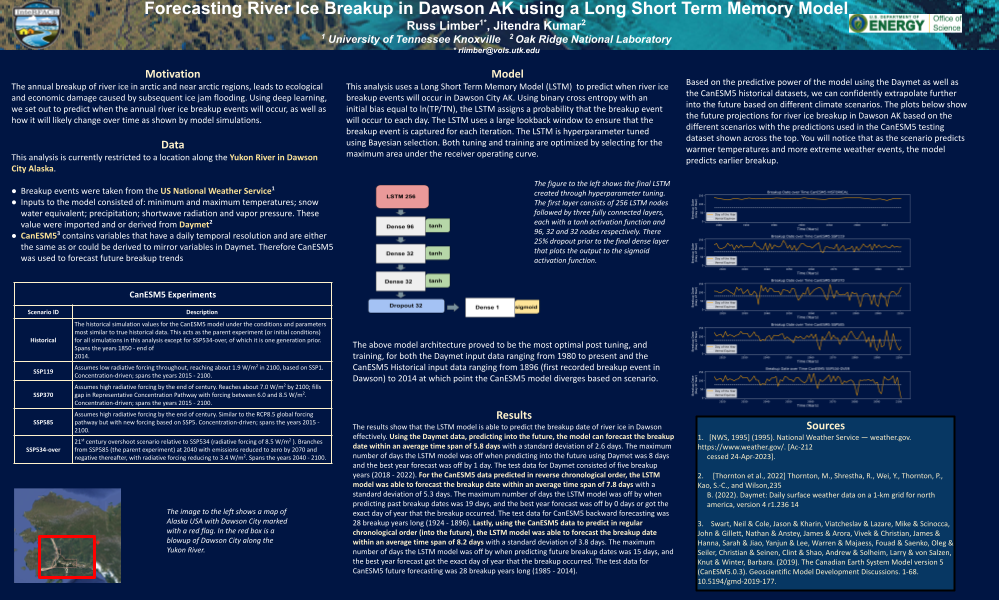08) Forecasting River Ice Breakup Using Long Short Term Memory Model
 Being able to accurately forecast when annual river ice breakup will occur across arctic rivers is of enormous significance for the ecosystems and inhabitants of those regions. The annual breakup leads to ecological destruction, damage to property and potentially even deaths. Forecasting when the breakup and subsequent ice jam induced flooding will occur, can help mitigate the impacts of these events. This analysis used breakup data collected from a site along the Yukon River in Dawson City Canada, ranging from 1896 to present. Those breakup dates were then combined with meteorological data provided by Daymet to predict breakup dates for that location, using a long short term memory model (LSTM). While Daymet was used to predict breakup dates within recent years (2018 - 2022) breakup dates were also combined with historical simulations from the CanESM5 model to see how well an LSTM could predict breakup dates from simulated data in both regular and reverse chronological orders (1985 -2014 and 1924 - 1896 respectively). The model created using the CanESM5 historical data was also used to project breakup dates into the future (2015 - 2100) for four model parameter settings: SSP119, SSP370, SSP585, SSP534-over. We found that for the five breakup events predicted using the Daymet data (2018 - 2022) the LSTM was off by an average of 5.8 days with a standard deviation of 2.6 days; the 28 breakup events predicted in reverse chronological order using CanESM5 simulated data (1924 - 1896) were off by 7.8 days on average with a standard deviation of 5.3 days; and the 28 breakup events predicted using CanESM5 simulated data
Being able to accurately forecast when annual river ice breakup will occur across arctic rivers is of enormous significance for the ecosystems and inhabitants of those regions. The annual breakup leads to ecological destruction, damage to property and potentially even deaths. Forecasting when the breakup and subsequent ice jam induced flooding will occur, can help mitigate the impacts of these events. This analysis used breakup data collected from a site along the Yukon River in Dawson City Canada, ranging from 1896 to present. Those breakup dates were then combined with meteorological data provided by Daymet to predict breakup dates for that location, using a long short term memory model (LSTM). While Daymet was used to predict breakup dates within recent years (2018 - 2022) breakup dates were also combined with historical simulations from the CanESM5 model to see how well an LSTM could predict breakup dates from simulated data in both regular and reverse chronological orders (1985 -2014 and 1924 - 1896 respectively). The model created using the CanESM5 historical data was also used to project breakup dates into the future (2015 - 2100) for four model parameter settings: SSP119, SSP370, SSP585, SSP534-over. We found that for the five breakup events predicted using the Daymet data (2018 - 2022) the LSTM was off by an average of 5.8 days with a standard deviation of 2.6 days; the 28 breakup events predicted in reverse chronological order using CanESM5 simulated data (1924 - 1896) were off by 7.8 days on average with a standard deviation of 5.3 days; and the 28 breakup events predicted using CanESM5 simulated data
(1985 - 2014) were off by 8.2 days on average with a standard deviation of 3.8 days. When forecasting breakup dates into the future, the SSP119 simulation shows relatively little variation with most breakup events happening after the vernal equinox whereas simulations SSP370, SSP585 and SSP534-over show greater variability with most breakup events happening well before the vernal equinox from 2080 onward.
